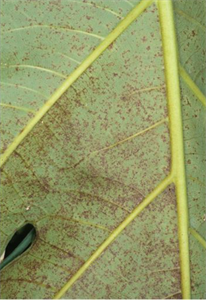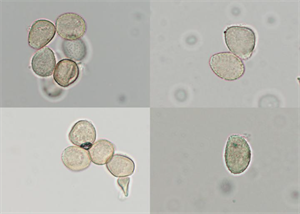Breadfruit rust. It is also known as leaf rust of breadfruit.
Pacific Pests, Pathogens, Weeds & Pesticides - Online edition
Pacific Pests, Pathogens, Weeds & Pesticides
Breadfruit rust (473)
Uredi articarpi
Southeast Asia, South America, the Caribbean, Oceania. It is recorded from Cook Islands, Fiji, Niue, Papua New Guinea, Samoa, Solomon Islands, Tonga, and Tuvalu.
Breadfruit and jackfruit, and other species of Artocarpus. In the Pacific, the rust is only recorded on breadfruit.
Uredo aartocarpi is a rust fungus that produces spore-containing structures (pustules) in brown spots on the under surface of older leaves (Photo 1). On the uppersurface of the leaves, there are brown discoloured areas corresponding to the infections below (Photo 2). The pustules are called uredinia and each is 0.1-0.2 mm diameter, best seen with a lens or microscope. They contain pale yellow urediniospores, which have thickened walls and are covered in short spines (Photo 3).
Rusts often have several spore stages, and sometimes two hosts. This rust is different: it forms only urediniospores and no other hosts are known apart from breadfruit and its relatives.
Spread occurs when spores are discharged in large numbers from the pustules and dispersed by wind. Spread can be over long distances as the spores are protected from the drying sun and wind by their relatively thick dark cell walls.
Mostly, the rust affects older leaves, causing little damage to the tree overall (Photo 4). Consequently, fruit yields are not likely to be affected. and the disease is considered to be of little economic importance.
Look for the characteristic minute pustules on older leaves producing masses of spores giving a rust-like powder when the surface is stroked with a finger. Look for the brown spots on the top surface of leaves, and leaves that die prematurely.
There are no management options as the disease is not considered to be of economic importance. Also, spread is by wind and the spores can travel large distances; because of this, countries yet free from the disease may conclude that quarantine measures are unlikely to prevent natural introduction of the rust.
AUTHOR Grahame Jackson
Information from McKenzie E (2013) Uredo artocarpi (http://www.padil.gov.au). Photos 1-3 Eric McKenzie, Landcare Research, Auckland, New Zealand (http://www.padil.gov.au/maf-border/Pest/Main/143079).
Produced with support from the Australian Centre for International Agricultural Research under project HORT/2016/185: Responding to emerging pest and disease threats to horticulture in the Pacific islands, implemented by the University of Queensland and the Secretariat of the Pacific Community.







